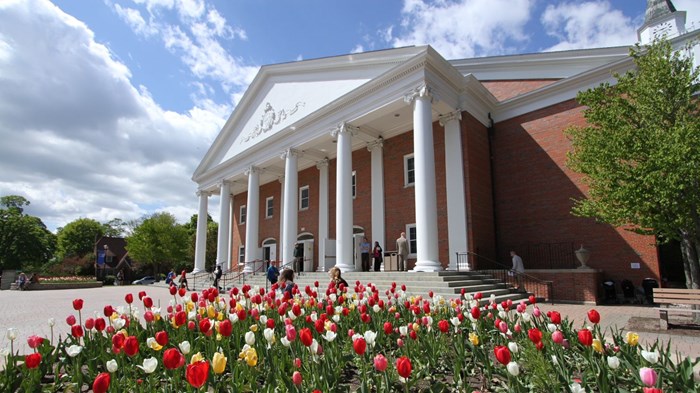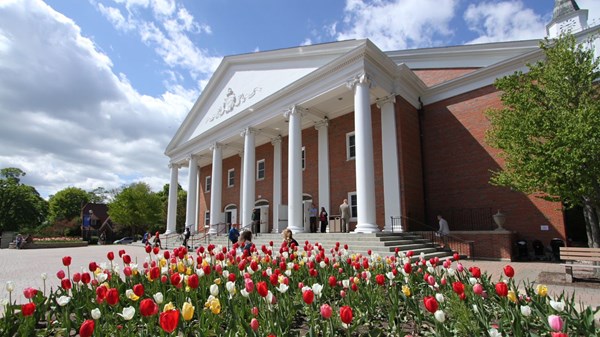

More than 65 years after two of its alumni were killed in what became the most famous example of missionary martyrdom in the 20th century, Wheaton College wants to tell a better story to honor their work.
Wheaton president Philip Ryken announced this week that a plaque honoring alumni Jim Elliot and Ed McCully along with Nate Saint, Roger Youderian, and Pete Fleming has been taken down from the campus chapel while a task force meets to suggest new phrasing to remove the word “savage.”
Elliot and McCully graduated from Wheaton in 1949. The five men were killed in January 1956 after making peaceful contact with the isolated and hostile indigenous group in Ecuador. The following year, their classmates donated the plaque, which includes relief images of Elliot and McCully.
In describing the tribe, then called “Aucas” (“savage” in the lowland Quichua language), the plaque reads, “For generations all strangers were killed by these savage indians.” Contemporary accounts of the mission now refer to the tribe by the name they call themselves, Waorani.
In his emailed statement, Ryken said the term “savage” is a pejorative term that “has been used historically to dehumanize and mistreat indigenous peoples around the world. Any descriptions on our campus of people or people groups should reflect the full dignity of human beings made in the image of God.”
Ryken and other members of Wheaton leadership have received about a dozen comments about the plaque this school year from students and members of the campus community, said Joseph Moore, Wheaton’s director of marketing communications. He said the president released the statement because the plaque has been temporarily removed, and leadership wanted the campus community to “know about its review, rewording, and return.”
The change comes at a time when Gen Z Christians are rethinking the church’s historical approach to international missions. Last year, a Barna study found that 38 percent of adults under 35 agreed with the statement, “in the past, missions work has been unethical,” compared with 23 percent of older adults.
The rewording of the Wheaton plaque also reflects how the narrative around the Ecuador missionaries has evolved. Elisabeth Elliot’s Through Gates of Splendor—written in just eight weeks and submitted right before the first anniversary of her husband’s death—became the “go-to evangelical account” of what happened, said Lucy S. R. Austen, author of a forthcoming biography of Elisabeth Elliot.
In subsequent writings, though, Elisabeth sought to dispel the idea of the Waorani as wild savages and Americans as the great saviors, particularly in her third book The Savage My Kinsman. She continued to minister and live among the tribe for years after the killings.
“But in evangelical America we have tended to keep right on telling and retelling the same little sliver of time, in the same streamlined version of events, with the same triumphal gloss that Elliot laid down in 1956, and the same almost exclusive focus on the five men themselves,” Austen said.
She hopes as Americans revisit the story of the slain missionaries, they will re-examine their attitudes toward it and what we focus on when we remember and retell such accounts.
“It seems to me that white Americans tended to have a faulty understanding of non-Western cultures when the plaque was given, and that now that we know better, changing the plaque would be a great chance to do better,” said Austen.
In recent years, several evangelical institutions have taken the opportunity to “do better” in the ways they remember their missionary past.
In 2016, Whitman College, named in memory of slain missionaries Marcus and Narcissa Whitman, dropped the mascot “Fighting Missionaries.” The Whitmans wanted to bring the gospel to the tribes living in the Oregon Valley, but their good intentions were mired by their sense of cultural superiority.
Members of the Cayuse tribe killed the Whitmans in November 1847, more than 11 years after the Whitmans first arrived and in the midst of a measles outbreak brought by white settlers that killed far more natives than white people.
“I do not think a mascot … should precipitate the difficult conversations around challenging ideas. A mascot is meant to be something around which supporters of a college, and particularly athletic teams, rally,” Whitman College president Kathleen Murray said at the time.
And the Haystack Monument, a marker on the Williams College campus commemorating five students who hid in a haystack during a violent storm and dedicated their lives to foreign missions, has received extra scrutiny in recent years, though it remains in its place on campus.
Wheaton has grappled with missionary violence in the past, too. For its first 73 years, the school’s mascot was the Crusaders, a name it dropped in 2000. In announcing the change, then-president Duane Liftin said, “I came to realize that those [Crusades] were not very happy episodes in Christianity. They are not something we want to glorify." The school is now known as the Wheaton Thunder.
Cross-cultural missionaries have always had to navigate the complexities of their role. Even in previous generations, Christians see examples of how leaders did so with cultural sensitivity and humility, said Lloyd Kim, coordinator for Mission to the World. He points to 19th century missionary Hudson Taylor—who dressed in Chinese clothing, grew out his hair like Chinese men, and required the missionaries with his China Inland Mission to do the same—as an example of humility in evangelism.
As international missions becomes more culturally diverse, one of the most significant changes is that mission agencies are letting national partners lead. Western missionaries, instead, come in as guests. “We’re trying to dispel the attitude that says, ‘We are the heroes coming to save you.’ We are coming in as learners,” Kim said.

Support Our Work
Subscribe to CT for less than $4.25/month


















